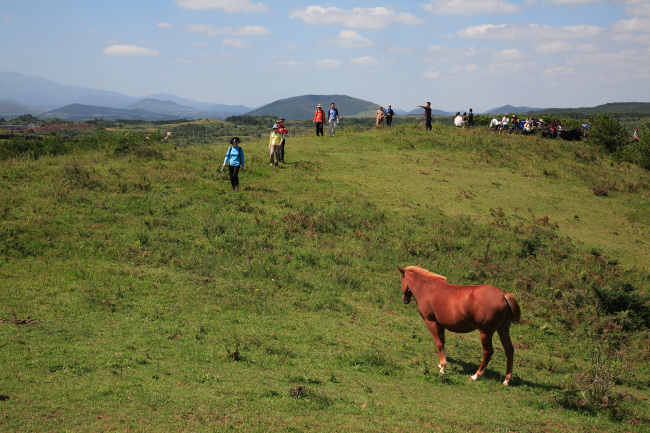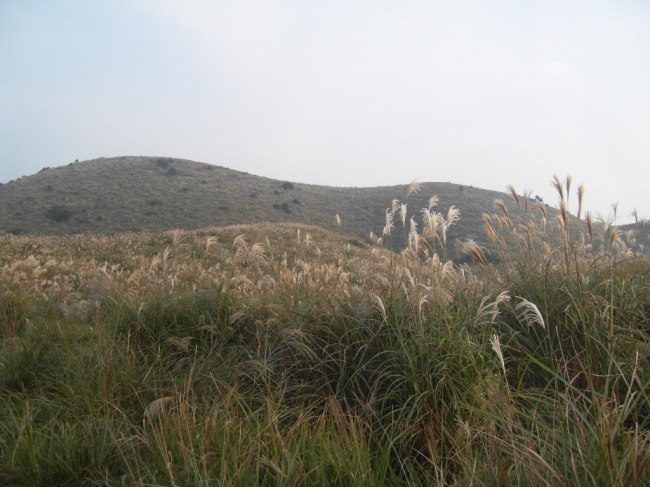JEJUDO ISLAND -- What is it about hiking and backpacking on a long trail that is so alluring?
There have been movies like “The Way” and “Wild” that tell the stories of characters trekking long distances to their destination.
Like in the movies, it is physically painful and challenging while on smooth, rocky, sandy and uphill roads.
But at the end, people can gain a sense of accomplishment, and most importantly, let go of sorrow, clear their minds and start anew like those characters endeavoring along California’s Pacific Crest Trail and Spain’s Camino de Santiago.
 |
Hikers trek the Olle Trail on Jejudo Island. (Jeju Olle) |
Jeju Olle Trail offers hikers the same effect that can help them forget the past and look toward the future.
With the beautiful natural surroundings of Jejudo Island -- the ocean, hills, beaches, black rocks, trees and mountains -- the Olle Trail, created by nongovernmental organization Jeju Olle, was made to help “clear troubled minds.”
“Olle” is a word from the local Jejudo dialect meaning a narrow alleyway leading from a house to main roads.
“Its underlying meaning is helping people open their closed hearts and minds,” said Paul Moon, Jeju Olle’s volunteer guide.
The beauty of the 3-kilometer course leading up to Pyoseon Beach on the Olle Trail’s 22-kilometer route along the island’s eastern coast will instantly take your mind off any worries.
It will motivate you to keep going, and try out the other 26 courses totaling a distance of 425 kilometers. Trekking on Olle may become part of your bucket list after you experience even a short leg of it.
Jeju Olle chief Seo Myeong-suk, a former journalist who was born on Jejudo Island, developed the Olle Trail from 2007-2011, earning recognition for its creativity using beautiful landscapes without any harm to the environment.
Her idea was to provide a road like Camino de Santiago for people to get away from “daily craziness and pressures.” Seo hiked the 800-kilometer Spanish pilgrimage route for 36 days in 2006 after she quit her reporting and editorial job.
In an effort to promote the routes, Jeju Olle has launched programs enabling foreign tourists to hike with English-speaking guides, and visit traditional villages and learn about Jejudo’s history and geography along the way.
Last year, about 10 million people visited Jejudo Island, 8 million of whom came from Korea’s mainland. Some 1 million, mostly Koreans, hiked on the Olle Trail. Those who complete all 425 kilometers receive a certificate after showing their Olle passports with stamps.
 |
Yongnuni Oreum, or Dragon Eye Mountain (Park Hyong-ki/The Korea Herald) |
Jeju Olle’s trail program also includes hiking up Yongnuni Oreum -- Dragon Eye Mountain, as its shape resembles a dragon lying down -- in Jongdal-ri.
From the parking lot, it takes around 15-20 minutes to hike to the peak, at 250 meters above sea level, and view its surroundings such as Jejudo’s wind power farms and Mount Hallasan, Korea’s highest mountain.
Late famous Korean landscape photographer Kim Young-gap loved Yongnuni Oreum so much that he had taken numerous pictures of it and its natural surroundings. Jeju Olle’s program also takes participants to Kim Young Gap Gallery Dumoak in Seogwipo.
Tourists will be able to book accommodations through Airbnb, which has been expanding its ties with Jejudo’s hospitality sector. For more information, visit
www.jejuolle.org.
By Park Hyong-ki (
hkp@heraldcorp.com)






![[Exclusive] Hyundai Mobis eyes closer ties with BYD](http://res.heraldm.com/phpwas/restmb_idxmake.php?idx=644&simg=/content/image/2024/11/25/20241125050044_0.jpg)
![[Herald Review] 'Gangnam B-Side' combines social realism with masterful suspense, performance](http://res.heraldm.com/phpwas/restmb_idxmake.php?idx=644&simg=/content/image/2024/11/25/20241125050072_0.jpg)

